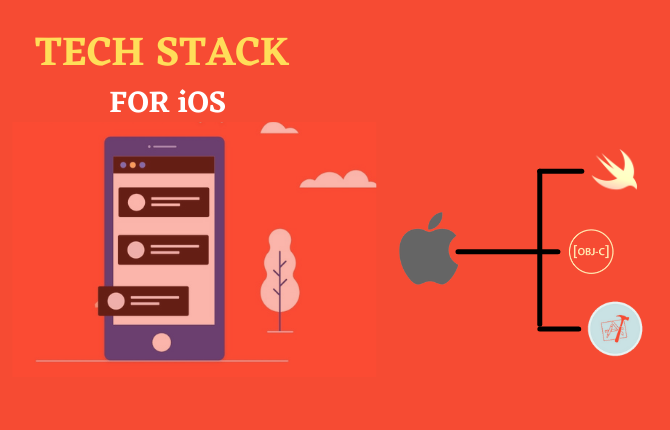
Mobile apps are becoming a go-to option for users in the digital world. Apps require a wide range of technology stacks to provide a valuable experience to the user.
As the competition is increasing, so are the developers’ available tech stacks, making it hard to decide on which is the best tech stack to use for the app development. Although there are two main operating systems in the mobile world; android and iOS, we will select iOS and enlist the right iOS mobile app technology stack required while developing an app.
Before stepping directly into the technologies, it is crucial to understand about app development tech stack.
What is an app development technology stack?
A technology stack involves programming language and other software products used while creating a mobile app. App development employ several tools, and choosing a perfect combination of tools is tough.
What happens when you choose right tech stack?
- When you clearly understand technology stacks, you can choose the best stacks that maximize your product or software performance.
- Developers can code faster when they have a robust choice of tech stacks
- When you know your technology stack and its structure, you can fix bugs easier
What happens when you choose a wrong tech stack?
When you choose the wrong tech stack, it affects your app development process.
- An unplanned selection of right tech-stack use will create additional time in deciding because it will be from scratch.
- When trying new tech stacks, the update cycle can be complex and disturbing without any fixed time of update delivery.
- Experienced developers trained on widely used tech-stacks might feel uncomfortable with new tech stacks.
So, what components are involved in a tech stack?
Components involved in a iOS Technology Stack:
IOS Tech stacks are based on the following pointers:
- Frontend: Client-side development is a crucial part of every app because the look, feel, and smoothness of an app determines its success. In the front end, user interface designing becomes a foremost part.
- Backend: It is the layer that is not visible to the clients. It is the backbone of every app that works between UI and database. It includes website architecture, scripting, programming of all the elements in the front end, and finally, database management.
- Analytics: Users encounter several bugs even after the deployment of apps. Developers must decide few analytical tools which they can use to determine the issues their customers are facing.
- In-app integration: Apps require several functionalities to embed to function seamlessly. Deciding on the payment platforms, navigation systems, and other useful features becomes a part of the tech stack decision.
Now you know about the components involved in tech-stacks, let’s explore about a perfect iOS tech stack.
Have a detailed insight of Complete iOS tech stack
Following are the programming languages, UI Frameworks, Crash analytics, and in-app integrations used in iOS tech stacks.
Programming languages
For iOS mobile app development, you must go for two major programming languages widely used; Swift and Objective-C.
- Swift: Apple owns Swift giving a strong reason for us to use it. It was launched under the open-source community in 2014, capable of creating robust apple ecosystem apps. It is rich in modern features used by Apple with new frameworks allowing diverse customization for the uses adapting the requirements of trends.
- Objective C: A flexible object-oriented programming language used in OSX and iOS devices for general purposes. Apple uses Objective C frequently on its legacy projects. Although, for the latest approaches on projects, Swift is more beneficial and used by developers.
iOS Toolkit
- XCode: This toolkit is continually updated by Apple with a complete set of tools used for app development in Macs, iPhone, and iPads. XCode wins an advantage over an organized testing and debugging process with a highly efficient user design.
- iOS SDK: It is apple owned software development kit for the iOS environment. The SDK efficiently integrates with Swift and objective C, flawlessly polishing the apps to the next level.
UI Frameworks
User interfaces come under primary task lists while developing apps. Below are the most common user UI frameworks in iOS:
- UI Kit: It manages graphical elements on the apple applications, iOS.
- SwiftUIM: The app is compatible with multiple frameworks but works only with the latest versions of iOS. So, developers can limit the users using older versions and push them to use new versions.
Crash analytics
While developing apps, developers encounter bugs and crashes, and it is important to use a proper analytics product to troubleshoot errors.
- Google analytics: Google and apple analytics provide details about traffic, and it also produces reports about the key issues that are not working for the users and company. On the apps, google analytics sends detailed reports to the developers about unexpected errors users face in apps. They also record users’ feedback, making it an important part of tech stacks.
- Instabug: Instabug works like other analytics but focuses on accelerating the workflow for developers with structured reporting and feedback. It also lets developers release apps with better confidence in the next releases.
In-app integrations
A stack is not complete without the integration of trending features. Below are a few of the most important integration that modern apps require.
- Payment Gateways: The audience is digital, and most of the big apps have integrated payment systems, whether it is on PayPal or GPay platform.
- Social Integrations: Integration of faster sharing with Facebook, Google, and Twitter makes it easier for users to share and connect their apps with the social platforms.
- Navigation technology: Apps use locations for several tasks where integrating apple maps is important while working on iOS apps.
Conclusion
Choosing a tech stack is totally based on the frontend, backend, analytics, and in-app integration. Selection of right iOS tech-stack app development makes it easier for developers while choosing app development technologies. Without a defined tech stack, developers may end up taking time and resources. If you are not a developer but still want an app, you can approach the best app development companies who work on the best tech stacks for iOS app development. Or, if you have an app but want to improvise, the right tech stack in iOS can skyrocket your app performance and increase user engagement.






